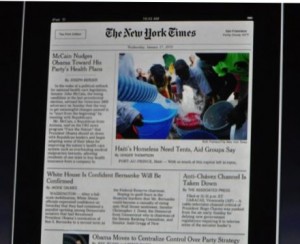Dwight Silverman recently provided a large number of “improvements” he feels are necessary for the next version of the iPhone. Here are my opinions on his thoughts:
A better camera: A 3 megapixel to 5 upgraded seems a minimal upgrade that should be expected. If it does include a better camera, it should also provide better programatic access to it. Allowing apps that use it to throttle the quality, especially those that use video, particularly streaming video. If you could stream low-res and save high-res at the same time, that would be ideal. It’s likely that cameras will appear in future iPod Touches as well, perhaps lower end versions.
Bigger and/or Better screen: The two aren’t the same thing obviously. Apple has been resisting the resolution “upgrade” because the one-size-fits-all has served their developers, and therefore their app breadth, well. Other platforms are already stratifying, and it’s not ideal. They will definitely need to provide the simulator support months in advance of hardwired availability, so that developers can confirm their products. They should also provide a way to run lower/original resolution applications, or risk minimizing available applications.
More customization: With each major release of the iPhone OS there are minor customization increases. There will be minor changes on this version and Dashboard-style widgets, custom backgrounds, or any other “skinning”-type functionality is unlikely. And in my opinion, unneeded.
A faster processor: Each hardware upgrade has included a processor improvement. Apple has no need or desire to be the fastest possible processor. More speed = more battery use. Apple will continue to err on the batter life improvement side.
Voice recognition throughout: Apple aims at the larger, non-technical market, and I think voice recognition and in particular voice dictation is a bleeding edge technology. This is still not available broadly on computers and mobile CPUs can’t handle it. The Nexus One offloads, necessarily, processing onto servers. This bandwidth increase would be undesirable, particularly to an AT&T already straining from the needs of the iPhone.
Multi-tasking: This is most yearned for feature that is the most unneeded. Apps can currently remember their states if they care about their users. Having Apple “sleep” an app also leaves an ambiguity of when the user really wants to quit the app. There are definitely some functionalities Apple should open up to developers that happen to be background ones. (Audio Streaming a la NPR app – The stream should be on par with the Apple Music app.)
Greater Durability: I disagree with Dwight, iPhones are strong enough. Their screens are considerably larger than most which naturally makes them more vulnerable. And insurance is usually available for those unable to handle the iPhone safely.
Thinner and lighter: a competing design variable to Greater Durability.
Relaxed App Approvals: Apple did recently “stream line” its app approval process and items are getting through the pipeline much faster this month than two months ago. A few more months are needed to see if this change is everything is needed. This general heading in Dwight’s list is there only for a specific argument: Google Voice. I would love to have that app, but any arguments are hard to make for lack of real information on why it hasn’t been green lighted. Lots of rumors and speculation.
End Its AT&T Exclusivity: Apple chose AT&T on technological reasons. There are two (different, and not quite equal) 3G technologies. Apple chose the one that can provide more technically and the one that blankets Europe and Japan. There were also technical modifications made to AT&Ts infrastructure to allow the “audio voice mail” that would need to be made by other carriers. Cingular has the same type of network; Verizon would require the manufacture of a different type of phone. I don’t think the growth spurred by non-exclusivity would be large enough to bother production.



